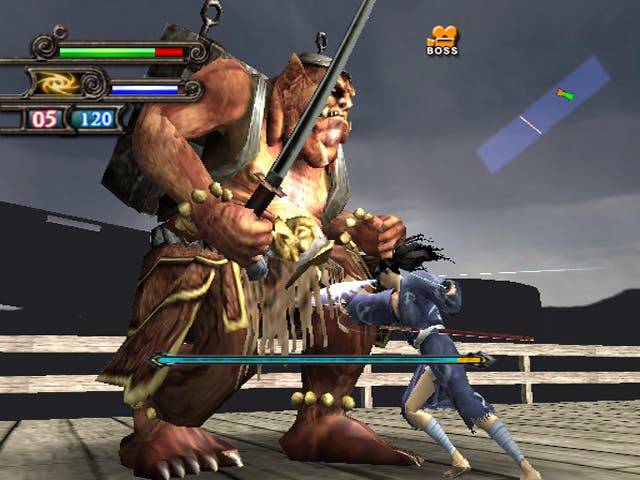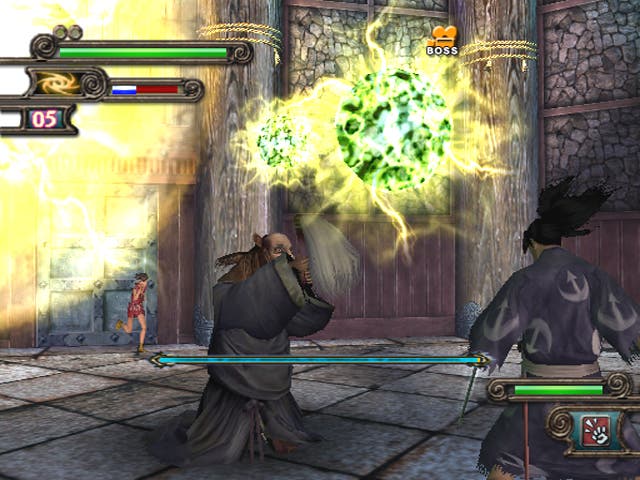Blood Will Tell
But only if you give it time to coagulate.

Yesterday I described myself as a latent human being. (Something to do with discovering I had a front door at the age of 21.) Today I find myself writing about somebody of whom it's a pretty accurate description. Hyakkimaru was stripped of arms, legs, facial features and a good number of other things at birth for a total of 48 ransacked body parts. Blood Will Tell charts his blood-soaked odyssey to retrieve them from the demons that hoodwinked his opportunistic power-hungry father into signing them over in the first place.
Unfortunately, we both make a poor first impression. I'm shy, insecure and fidgety to begin with; Hyakkimaru's repetitive, overly simplistic and lives in what looks like first-generation PlayStation 2 game - at this point, the gaming equivalent of living with your mum well into your 30s. Fortunately for him though, I'm a sympathetic sort, and a week down the line, now that he's been reacquainted with a few of his looted extremities and grown into himself, I've decided he's a thoroughly interesting human being, and well worthy of my thumbs' attention.
It wasn't easy though - in a lot of senses. The prospect of hacking and slashing through Osamu Tezuka's mythological take on feudal Japan and tackling the 48 boss-demons ("fiends" to their friends) seems all the more exhausting when you first sit down with the game and its remarkably jagged, unremarkably animated characters and enemies start to do battle in identikit villages awash with fuzzy textures - and rendered for the purposes of the prologue in black and white. As you slide into the grind of mashing the two main attack buttons to take down numerous identical enemies and start tackling the (initially extremely forgettable) bosses, there isn't a great deal that fills you with excitement.
This isn't helped by some deliberate quirks of the camera and controls. There's nothing catastrophic about either, but the problems you do encounter are just so expected in a game that begins so blandly. For example, the way the game sometimes seizes camera control from your right stick and switches between fixed perspectives to confuse your movement controls. Or the way Hyakkimaru's Devil May Cry-style arm-stump-mounted machinegun fallback can only be fired while he's standing still and takes a split-second too long to warm up. Surely a DMC-style system would have fit in far better with the otherwise balletic sword combat.

Impatient gamers could be forgiven for simply turning it off at this point and looking elsewhere for immediate gratification. But stick with it and it starts to improve. Hyakkimaru retrieving his left eyeball from the second boss throws it all into colour, which, though it would've been far more impressive if he'd thrown a bucket of polygons over the game instead, alleviates some of the dullness. As do the hefty finishing moves. When you hold triangle long enough for Hyakkimaru to draw his sword back and let it light up with energy, he'll thrust it into an enemy and you'll be given a randomly generated sequence of the lower three face buttons to hit to land blows. Land enough before your time is up and then reach for triangle to finish and you'll kill the enemy in question off. The clever bit being that you're still susceptible to damage from other enemies while you do this, and the more button presses you complete before the time is up the better the dropped items will be.
You'll also meet Dororo, a young thief of ambiguous gender, who fights alongside you (sensibly without his/her survival becoming too mission-critical) and forms the basis of neat pace-changing interludes that involve sneaking around somewhat stealthily solving simple locked-door puzzles and leaping between platforms. She also adds a bit of colour to the story, the telling of which quickly starts to accelerate and the quality of which quickly starts to dawn. Okay - it's one of those fascinatingly improbable Japanese manga ideas that demands imagination to accept, but it's beautifully told by an even-paced narrator speaking over a series of gorgeously tapestried illustrations, regularly pauses to clarify points by delving back into the character's origins and - over the course of the rest of the game - comfortably twists and turns until you're well and truly wrapped up in it.
The greatest thrill though is the gradual retrieval of Hyakkimaru's body parts, each of which is beneficial in some way. Some will simply improve his statistics in a vital area - improving health regeneration, for example - but others will open up new abilities, both manual, like a dash control, and innate, like a greater propensity to land on his feet after a fall. Better - the 48 fiends of the story are not all located along the relatively obvious path from beginning to end, and developer Red has been inventive with the nature of their body part pay-offs. Many will require you to return to completed chapters and seek them out by locating glowing red stars on your mini-map and working out how to trigger the fight, and these chaps proffer parts that add superfluous features like a kill count in the pause menu. I like that.

It's also refreshing to note that despite rarely obscuring the path to progress, the development team has been prepared to build large levels full of bits you may never even explore, and equally unafraid of having you retread the same path when it makes sense - traipsing back and forth around a mansion in the first chapter, for example, subtly varying the route to reflect the way you might actually find yourself exploring it at different junctures.
After a while you realise that it's pushing your klepto buttons, holding your attention with its unorthodox story and flair for storytelling, clearly replayable and, last of all, home to a surprisingly deep and varied combat system.
I've already mentioned the arm cannon and you've assumed the man has a sword, which is accurate, but Hyakkimaru's a lot more versatile than that - and grows more and more so. To begin with, he has a pair of blades for arms, which is a peculiar sight but advantageous in cartwheeling at enemies and attacking on two fronts. He can also accumulate a vast array of swords, some of which have particular advantages or disadvantages against certain foes, adding a degree of strategy to proceedings. He also has a knee-mounted grenade launcher, although ammunition is pretty scarce, and when thrown into combination with his various other tools, two different players could conceivably fight every battle in the game without falling into the same patterns. The only pity is that Hyakkimaru's spirit attacks - invincible and marauding attack sequences that you can activate once your spirit bar is full from clobbering enemies - aren't that different to one another.
However, our conviction that you'll enjoy it over time is mitigated somewhat by the inconsistent quality of the bosses and level design, and a general sense of graphical inadequacy that, considering how good SEGA's other mythical Japanese slasher Otogi has been made to look, proves continually upsetting. In terms level design, again it's not that they're dreadfully poor; there are just too many things that prompt you to grumble. Like the way Dororo's platform-jumping and spike-trap-dodging exploits are upset somewhat by the squirrelly movement controls and lack of proper analogue movement, the unexciting geometry and tendency to recycle elements and throw the camera around, and, in the case of the bosses, the sheer volume and mundanity. Fortunately you can at least say that the restart system and frequency of save points is suitably generous.

The bosses, though, are Blood Will Tell's raison d'être, - they're almost literally the lifeblood of the hero, after all - but don't feel like it. Games built around bosses are hard to do, but if you do attempt them you have to go all out, as Wanda and the Colossus appears to be doing. Make them big, memorable and inventive in their means of dispatching you. To do otherwise, as Blood Will Tell unfortunately does, is like advertising a U2 gig by promising "all the songs you remember" and then getting them to play a set consisting mostly of nursery rhymes. As it is, a lot of the bosses are big and a lot of them are memorable, but there are absolutely loads whose simplistic attack patterns and unconvincing looks are more Ba Ba Black Sheep than Where The Streets Have No Name.
Some of them are a bit too difficult, too. It's clear from the upward curve that the designers hoped and wanted you to spend time exploring the game as you played through it, choosing to fight and level up more often than to abstain, but this does also mean that sometimes you're left hopelessly ill-equipped and can get caught in a cycle of frustration that's difficult to escape from without losing some degree of progress. And the number of boss-like fights that offer no reward and how often they fall into Ba Ba Black Sheep or bastard-hard territory is disappointing.
None the less, Blood Will Tell is a lot more intricate than at first appears. It may be something of an ugly duckling, and it's depressingly likely that it'll sink without trace as a result, but after a few stumbling steps it soon becomes apparent that Hyakkimaru's journey to find the sum of his parts is indeed greater than the sum of the game's. If you like slashing and hording within intelligently structured worlds and have no problem sinking into the non-conformity of Japanese manga, then Blood Will Tell may well surprise you.

